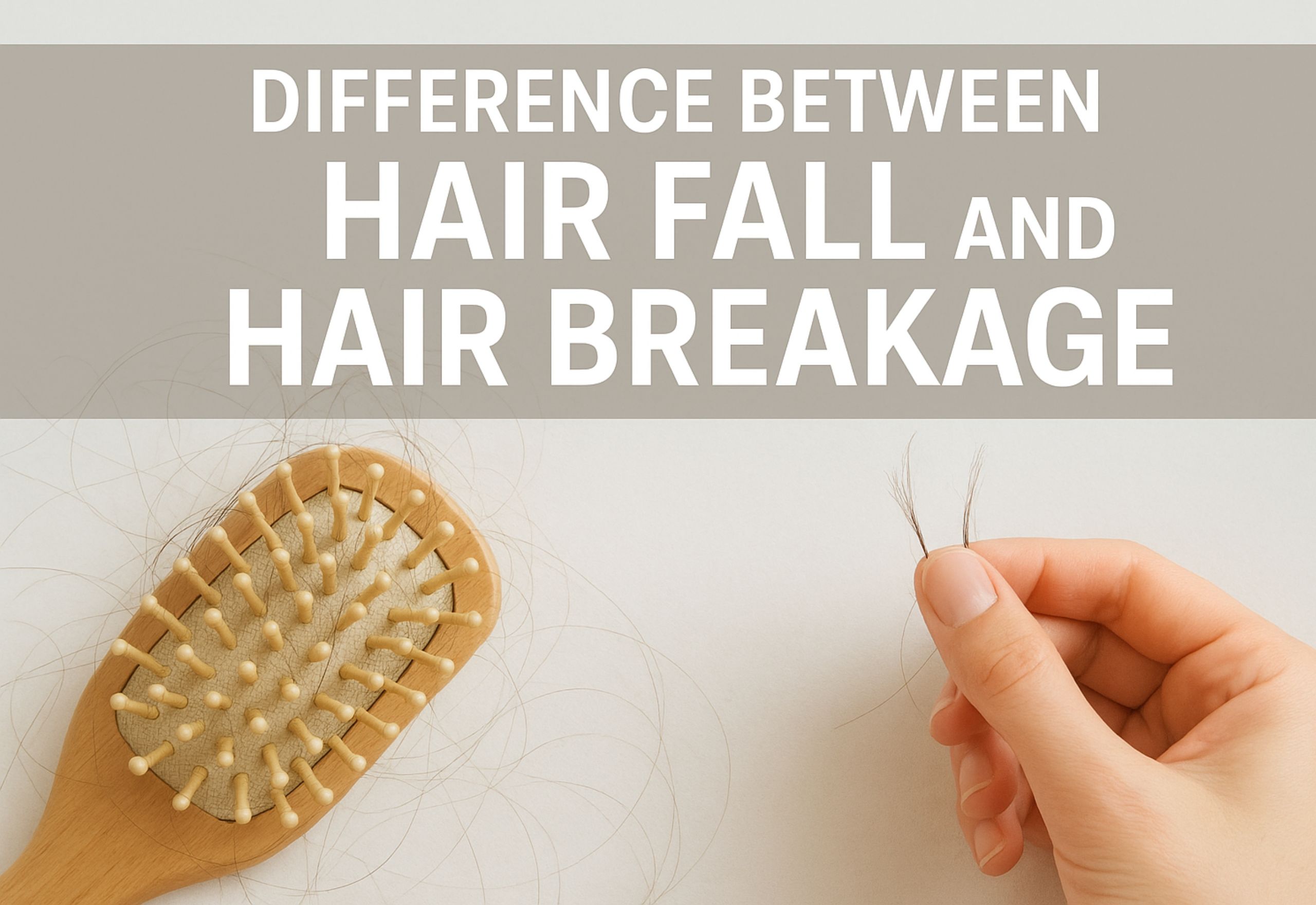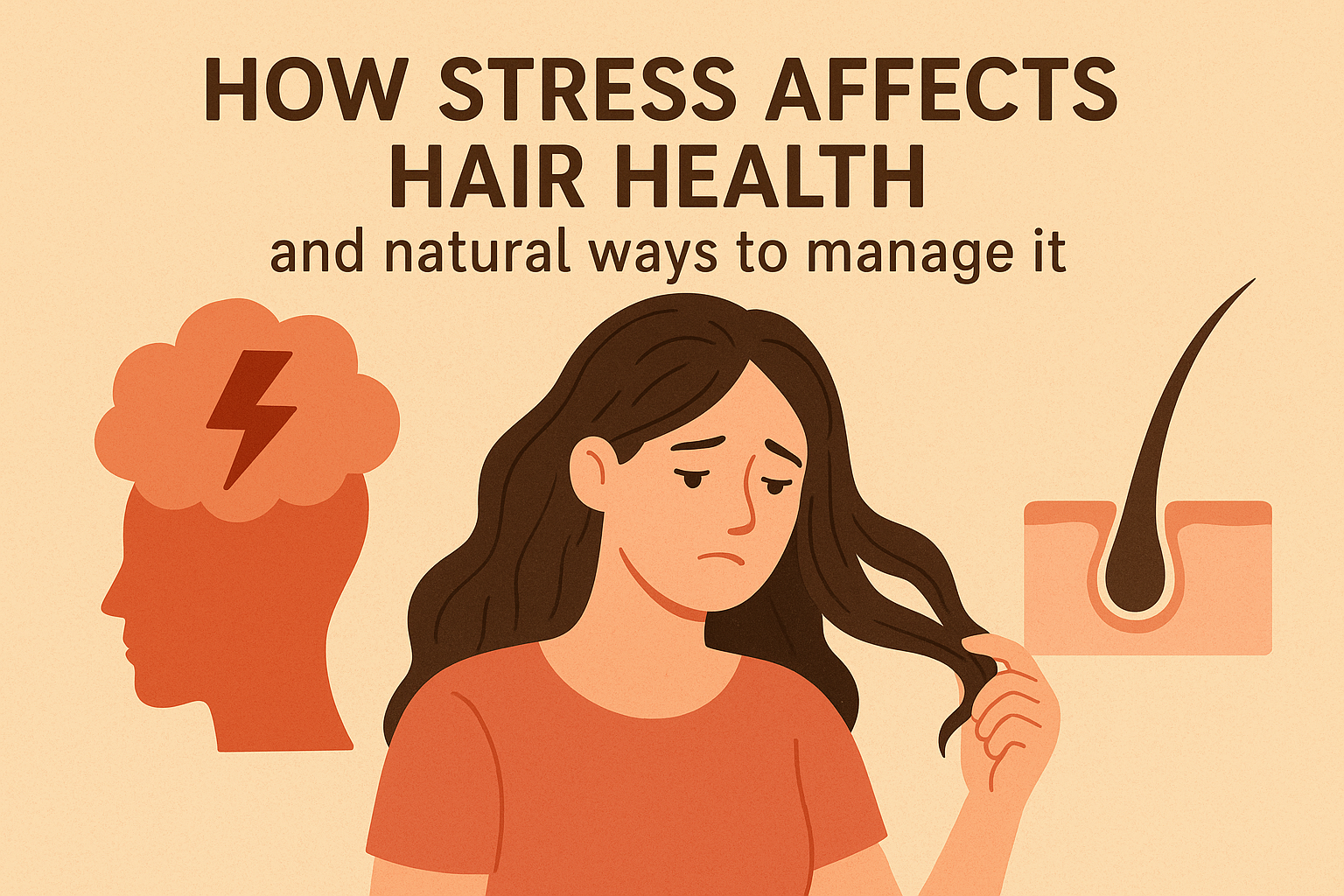Hair on your brush can feel scary. Is it hair fall from the root or breakage along the shaft? The answer guides what you do next. Hair fall points to scalp or follicle processes, like temporary shedding after stress or patterned thinning. Hair breakage points to damaged fiber strength, often from heat, color, traction, or rough handling. This is why understanding the difference between hair fall and hair breakage becomes important. Both can happen at the same time, which is why a simple plan and a few at-home checks can save you months of confusion.
Hair Fall and Hair Breakage at a Glance
Hair Fall
- The strand detaches from the root.
- You may see a small bulb at one end of the shed hair, called a club root. This is common in the resting phase of the cycle and in telogen effluvium.
- Shedding can be diffuse or patterned. Diffuse shedding often rises two to three months after a body stressor such as illness, childbirth, or major weight change.
- Typical daily loss is about 50 to 100 hairs. Moreover, for several weeks, it suggests excessive shedding.
Hair Breakage
- The fiber snaps anywhere along the shaft.
- Broken bits have no bulb at the end, often look jagged or frayed, and lengths vary. Causes include heat, bleaching, tight styles, and friction.
- You might notice rough ends, split ends, and more short flyaways than usual around the hairline and crown.
The Hair Growth Cycle
Think of your follicles as tiny factories that run on a schedule.
- Anagen, the growth phase: lasts for years on the scalp. Longer anagen, longer hair potential.
- Catagen, the brief reset: a few weeks of transition as the follicle shrinks and forms the club hair.
- Telogen, the rest: several months of pause. The resting club hair sits loosely and can shed. A small fraction of your hair is always here.
How to Check Hair Fall and Hair Breakage at Home
The root check
- Look for a tiny bulb at one end. A visible club root points to shedding from the follicle, not snapping mid-shaft.
The length and tips check
- A pile of hairs all close to your normal length with bulbs suggests shedding.
- Many shorter, jagged pieces with frayed tips reflect breakage.
The pattern check
- A diffuse increase in daily fall two to three months after a stressor suggests telogen effluvium.
- Expanding part or thinning at the crown over months to years points to androgenetic thinning, which comes from follicle miniaturization.
- Smooth bald patches without scale suggest alopecia areata, which needs medical review.
The touch test
- Hair that feels rough, snags easily, and frizzes after washing often has surface damage and cuticle wear, so breakage risk is high. It is generally linked to heat, chemical processes, and traction.
Root Causes: Hair Fall
Normal Shedding
About 50 to 100 hairs per day. Some days more, some less. This by itself does not thin out the scalp.
Telogen Effluvium
A spike in shedding that begins two to three months after triggers like febrile illness, surgery, childbirth, rapid weight changes, new medications, or major stress. It usually settles in three to six months after the trigger resolves, and new growth follows.
Androgenetic Hair Thinning
Gradual reduction in hair fiber diameter and density at specific regions, such as the crown or front. The hallmark is follicle miniaturization.
Autoimmune Patchy Loss
Alopecia areata creates smooth patches or diffuse shedding. Care is medical, not cosmetic.
Medical and Nutritional Issues
Thyroid imbalance, anaemia, low ferritin, severe protein-calorie restriction, and certain medications can raise shedding. Clinical pages from major hospitals list these among common triggers. Moreover, a clinician can test and treat the cause.
Root Causes: Hair Breakage
Heat and Chemical Processing
Frequent high-heat tools, bleaching, permanent colour, and relaxers strip and erode the cuticle, creating weak points that snap under tension.
Traction and Friction
Tight styles, heavy extensions, repeated back-combing, and rough towel drying raise break rates. Chlorine and the sun also add surface damage.
Inherent Shaft Defects and Wear Patterns
Trichorrhexis nodosa can be inherited or acquired, often linked to repeated trauma and chemical exposure. Under the scope, the shaft shows nodes and broken fibers at those nodes.
Additionally, maintaining good scalp health matters. Scratching from itchy conditions like seborrheic dermatitis or lice can worsen mechanical damage.
Quick Comparison Checklist
Hair fall
- You see a tiny bulb on one end.
- Strands are near your full length.
- Shedding rose two to three months after a body stressor.
- Scalp density looks even, or you notice a widening part over months rather than many short stick-outs.
Hair breakage
- No bulb on the short pieces.
- Ends look split or jagged, and the bits vary in length.
- Rough feel and more flyaways, especially around edges.
- You have a recent history of heat, bleach, tight styles, or aggressive brushing.
Step-by-step Plan For Hair Fall
- Log the timeline
Note major events in the past three to four months. Childbirth, a high fever, surgery, crash dieting, or stopping oral contraceptives can all precede a shedding surge. Moreover, this timeline helps your clinician connect the dots fast. - Check the daily load
A gentle wash day can release the hairs that are ready to shed. A spike above your usual for several weeks points to an active shed rather than a single heavy wash day. - Screen common medical drivers
If shedding remains high, book labs for ferritin, iron studies, TSH, and a basic panel. Large clinical guides list thyroid and iron issues among common culprits. Additionally, review medications with your clinician. - Protect the scalp
Use gentle cleansers and avoid harsh physical scrubbing. If you have itching or flaking, an anti-dandruff routine can reduce scratching and secondary breakage. If patches are smooth and well defined, seek medical review for possible alopecia areata. - Expect a lag
In telogen effluvium, shedding ramps up after the trigger and usually settles in three to six months as new growth emerges. However, if it persists or worsens, get evaluated.
Step-by-step Plan For Hair Breakage
- Dial down the heat
Lower the temperature, reduce passes, and always use a heat protectant. Clinical resources connect frequent high heat to cuticle loss and breakage patterns. - Space out chemical processing
Bleach, relaxers, and permanent color compounds can cause damage when stacked close together. Stretch appointments and ask for bond-aware methods. Cumulative chemical stress is linked to trichorrhexis nodosa and fracture points. - Loosen traction
Swap very tight styles for looser ones and avoid sleeping in heavy extensions. Traction strains both the shaft and follicle. Additionally, use soft scrunchies and avoid metal clamps. - Reduce friction
Pat dry your hair with a cotton T-shirt or microfiber towel. Sleep on a smooth pillowcase. Comb from ends upward with a wide-tooth comb, especially on wet hair. - Trim and treat ends
Micro-trims remove split tips that keep tearing upward. Follow with a consistent conditioning routine to improve slip and reduce daily wear.
Care Routines For Hair Fall and Hair Breakage
Here are some routines that can help you deal with your hair fall and hair breakage.
Cleansing
- Pick a gentle shampoo for your scalp type. Oily scalps do better with regular cleansing. Dry scalps may like fewer washes with a richer conditioner.
- If you have flakes or itch, a medicated shampoo used as directed helps. Moreover, reducing itch can curb scratch-induced breakage.
Conditioning
- Use a rinse-out conditioner after every wash to improve slip.
- For very dry hair, add a weekly or biweekly mask.
- Be generous at the ends, which have the most wear.
Combing and styling
- Detangle in sections from the ends up.
- Switch to lower-tension styles and avoid daily tight ponytails.
- Keep hot tools for special days. Air-dry partly before blow-drying.
Nutrition and lifestyle
- Aim for steady protein, iron-rich foods, and a balanced plate.
- Manage stress with sleep, activity, or any method that helps you feel grounded. Telogen effluvium often tracks with higher stress periods.
When to See a Clinician
Book an appointment if you notice any of the following:
- Shedding that stays high for more than three months, especially if you can fill your palm on wash days again and again. A clinician can confirm telogen effluvium and search for triggers, then track regrowth.
- A widening part, a see-through crown, or pattern changes over months. This pattern points toward androgenetic thinning, where early care can help.
- Round and smooth patches without scale suggest alopecia areata. These conditions generally need medical treatment.
- Scalp burning, itching, scaling, or pain. These issues can hint at inflammation that can raise both shedding and breakage.
- Sudden loss in clumps or with eyebrow or lash involvement. That warrants quick evaluation.
The clinician will review your history, examine the scalp, possibly do a gentle hair pull test, and suggest labs. Moreover, they may use a dermatoscope to look at follicles and hair shafts. Treatments generally depend on the cause and can include topicals, oral medicines, light therapy, or procedural options in some cases.
Summing it up
Learning the difference between hair fall and hair breakage is important in treating your condition. While Hair fall is a detachment from the follicle, often with a club bulb, and can be normal, stress-related, autoimmune, or patterned, hair breakage is a fiber problem, with no bulb, and links to heat, chemicals, traction, and friction. In some cases, both can show up together.
If your main issue is hair fall, focus on triggers, scalp comfort, and medical screening when needed. If your main issue is hair breakage, you should focus on gentle handling, lower heat, spaced chemical treatments, and friction control on your hair.
Related FAQs
How many hairs can I lose in a day and still be fine?
Most people shed around 50 to 100 scalp hairs per day. The number varies by wash frequency and hair length. If the count rises well beyond your usual for several weeks, look for triggers and consider a checkup.
Can telogen effluvium and breakage happen at the same time?
Yes. You might shed more from the root after a stressor and also see snapping on worn ends from heat or bleach. The fix is two-part: calm the trigger and protect the fiber.
I see little white bulbs on shed hairs. Is that bad?
A small bulb on the end usually indicates a club hair from the resting phase, which is common during normal shedding and telogen effluvium. The follicle remains in place and can grow again. However, if shedding stays high, seek evaluation.
Does patterned thinning count as hair fall?
Yes. Patterned thinning involves changes within the follicle that reduce hair caliber and density in certain regions. It is a root-level issue, not a breakage.
What is trichorrhexis nodosa in simple words?
It is a breakage pattern where the shaft develops weak nodes because the outer cuticle is damaged. Hairs snap at those points. Heat, bleach, and friction are classic drivers.
Do I need supplements for shedding?
You only need supplements if tests show a deficiency. Medical references list thyroid imbalance, iron deficiency, and some medications as common contributors to shedding.
What should I do when my ends keep snapping even after I cut them?
Turn down the heat, spread out the chemical processes, and reduce traction. Use a conditioner every wash to improve slip. Moreover, handle hair gently when wet, since wet fibres stretch more and can snap under tension.


